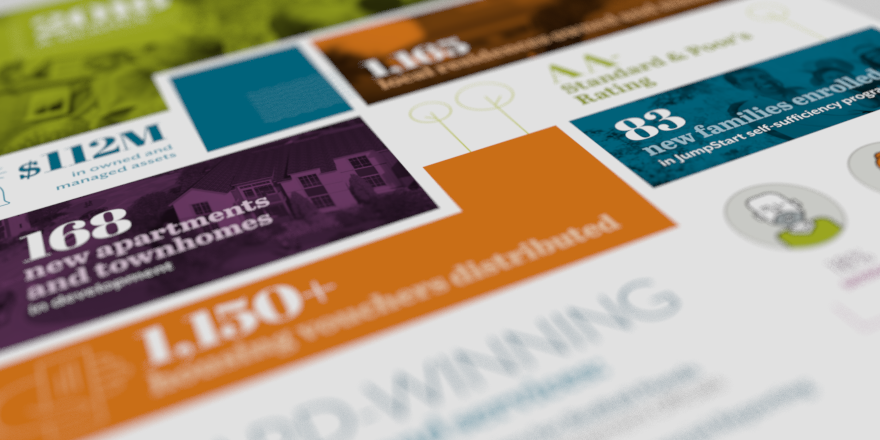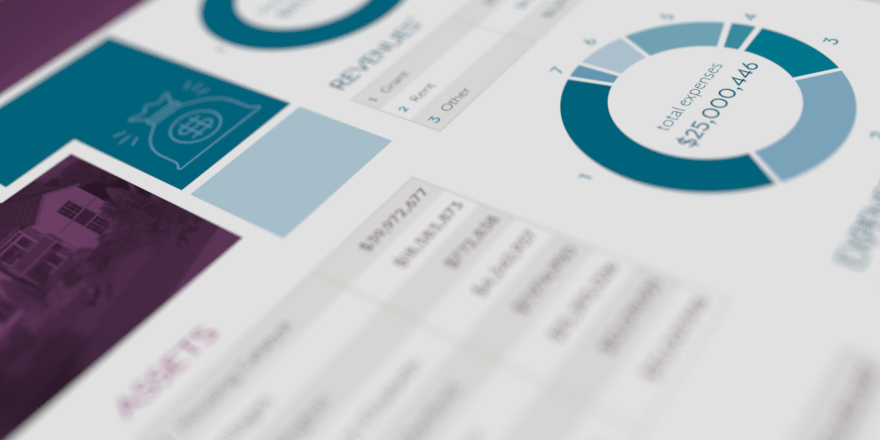You know your Housing Authority is doing good work, important work. You have great stories to tell, and they need to be heard. In a world where people make decisions in seconds about whether or not they are going to read the next paragraph, the window to capture your target audiences could close with a resounding snap before you’ve had the chance to tell them why your organization’s work is so critical. And once they’re gone, it’s very difficult to reel them back in.
You’re probably nodding your head. This isn’t new information. But, you might be asking, how do you tell your stories so they are compelling and make a lasting impression — and more importantly, sway affordable housing detractors, build relationships with developers and city officials, and further your efforts?
Read on for our tips on how to create impact statements and reports that make your case to a broad array of audiences, without having to craft individual cases.
Less is more
People don’t want to wade through pages and pages of dry statistics. They want access to relevant information quickly and easily. Use headlines, subheads, bulleted and highlighted text to call out the most important information. Be judicious. Think about your messaging like a race — not everything can come in first place. If your audience only comes away from your impact statement with one piece of information, which one do you want it to be? What’s the next most important message? And the next? Emphasize your information in a hierarchy accordingly.
Be concise, not verbose. Remember, the point is to make your points quickly, with the most impact. Use blocks of clear, compelling, succinct text. Add some color to the mix to indicate emphasis and break up a page that might otherwise be an overwhelming wall of text.
Kim Iwanski, Housing Catalyst’s Manager of Communications, likes the less-is-more approach the Fort Collins-based agency has applied to its impact statement. “We have redirected our communication efforts to be more direct and concise in our messaging,” she said. “In focusing on our impact, people better understand who we are and what we do.”
Examples of effective targeted messaging Housing Catalyst uses include:
• Housing is the catalyst for building strong communities.
• We’re reinventing how people access, experience and perceive affordable housing.
• We’re building community and inspiring change.
Statistics don’t have to be boring
Numbers tell a story, too, and can show how your Housing Authority has impacted the community with documented, verifiable data. Make it user-friendly. Infographics and tables are powerful tools when transmitting this type of information. They take those big chunks of data and distill them into easily digestible bites.
Human interest is interesting
Show the human side of your statistics. Every single family in every single home in every single community in your portfolio is another story you can tell. Add testimonial statements that make your clients and their stories relatable — and give your messaging the warm fuzzies. These stories are powerful statements, especially when people make the connection that your clients are their neighbors, peers, co-workers and/or service providers. Consider sharing:
• How a stable, safe and affordable home has impacted a family or individual
• What they are able to do now that they couldn’t in the past
• How their children are doing in school, as it relates to wellness as well as academics
• How individual success stories add up to overwhelming community impact
• How economic diversity builds robust, well-rounded communities
Don’t forget the impact of photographs. Putting a face to a story makes it that much more relatable and persuasive.
It’s about all of us
Above all, build messaging around how housing affordability is about the community as a whole — collective impact. A rising tide lifts all boats. When our neighbors can all afford to live here, we all thrive together.
Focus your messaging on how your organization provides a hand up, not handouts. Emphasize the reality of housing costs increasing faster than incomes. Discuss how stable housing is critical to children and has a direct effect on the future adults they will become. Point out the positive economic impacts affordable housing has on the community, from empowering your clients to become self-sufficient to creating jobs for developers, builders, service providers and beyond. Housing affordability is so much more than making sure low- and middle-income folks have a place to call their own. It’s about all of us, regardless of where we are on the socioeconomic scale.
Impact statements are just that — your chance to make an impact on your audience. When Housing Authorities devote the resources to creating a well-crafted report, it provides an open door for their audiences to walk through and learn more.
About Michelle Venus:
Michelle is Toolbox Creative’s business development goddess. Outside of fostering relationships with mission-driven organizations, Michelle is a natural storyteller and avid enthusiast of local art and live music. You can often find her pedaling her bike through Old Town Fort Collins, seeking and sourcing information.
About Toolbox Creative:
Toolbox Creative is a branding and marketing firm based in Fort Collins, Colorado with a strong focus on helping Housing and Redevelopment Authorities assess their brand equity, clarify their positioning and amplify their voices — creating lasting impact.




